Hey! This site is reader-supported and we earn commissions if you purchase products from retailers after clicking on a link from our site.
Playing pickleball is addictive thanks to the high cardio agile movement and exhilarating action. For a dedicated player, each time you step on to the court, you want to prove something. Such is the elation that even when you’re playing against a higher-ranked opponent, the nervousness fades away as soon as you hit the court.
Whether you’re a beginner or an experienced pickleball player, you can relate to the excitement and enthusiasm that comes with this sport.

Image Credit: NBC News
Winning a couple of games against your siblings and friends might give you a sense of accomplishment. However, that’s far from what you experience when playing at a professional level. if you want to transition your passion for this sport into a professional pickleball career, here’s everything that you need to know.
Rules:
When talking about basic rules, we’re not going to bore you with the ground basics of the game. Since you have already been playing the game, it can be assumed that you are aware of the basic rules. Thus, here, we will talk about the rules that will get you ready for the tournament.
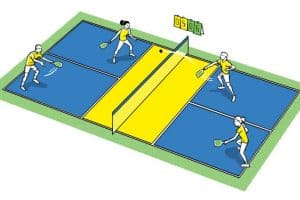
Image Credit: DMagazine
Scoring Rules:
Before you learn different things about pickleball, you need to understand the rules of scoring first. If you know the right way to score and keep a track of it, you can strategize the game to win:
Doubles Scoring:
The first and the most important thing about scoring, the points are only scored by the serving team and not the receiving. When the game starts, the player on the right side serves to the diagonally opposite side of the court.
The server moves to the left side of the court (odd court) and serves to the diagonally opposite side of the court when a point is scored. And players on the serving side move from left to right each time a point is scored.

Image Credit: DMagazine
The first server continues to serve until the serving team commits a fault and loses a rally. When a fault is committed, the serving then passes on to the second server. After the second server loses the serve, the serving is then passed on to the other team.
Singles Scoring:
The scoring in a singles game is similar to the doubles game apart from the fact that there are no second servers. Serve is done from the right side when a score is an even number and from the left side when the score is odd.

Image Credit: USA Pickleball National Championships
The serving position is decided by the server’s score and not the receiver’s, the receiver has to get in the position on the right or left according to the server’s score.
Calling the score:
When playing pickleball, the score should be called as three numbers. The correct way to call out the score is by saying the server score, receiver score, and the server number. At the beginning of the match, the score will be announced as 0-0-2.
Game points:
Pickleball is a point-based game and to win you have to score more points than your opponent to win. It doesn’t end here professional pickleball tournament has three rounds and the player who wins two of them is the winner.
Each round is 11 points.
Ball bounce Rule:
The ball bounce rule may seem basic but it has great significance in the pro games. It is the initial rule that starts the game. When starting the game, the player on the serving side has to serve the ball and ensure that it lands on the opponent’s court with a bounce.

Image Credit: USAPA
Similarly, when receiving a serve, you have to ensure that the ball bounces once in your court before you send it back.
Non-Volley Zone/Kitchen:
A pickleball court is very different from a badminton and tennis court. It is smaller in size and has a 7-foot long no-volley zone or affectionately referred to as ‘Kitchen’. It is prohibited to hit a volley in this zone and doing so is considered as a fault.
Pickleball Facts:
- There are over 200,000 USAPA registered players.
- Pickleball is played by over 2 million people
- There are more than 13,000 indoor and outdoor courts in the USA
- It is the fastest-growing sport in America and has estimated 8 million players worldwide
- Among the many people that play pickleball, 53% are males and 47% are females
Faults:
A fault is basically any act that halts the game due to a rule violation. However, unlike other games, the outcome of faults in pickleball is totally different.
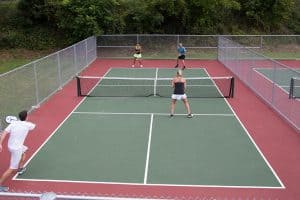
Image Credit: Dick Sporting Goods
A fault committed by the receiving team will result in a point for the serving team. When both players from the serving team commit a fault, it will result in a loss of serve or sideout.
What acts are considered as a fault in pickleball:
- When the ball is hit into the nets or out of bounds
- The serve fails to land within the confines of the receiving court
- When a player breaks the two-bounce rule and volleys the ball.
- The ball is volleyed from the no volley zone.
- When the ball bounces twice before being hit by the receiver
- A player or his clothing or any part of a player’s paddle touches the net or net post when the game is on.
- When the service is done improperly
- The player or anything is worn by the player is hit by the ball
- The ball strikes any permanent object before bouncing on the court
- When the server serves before the referee calls the score in an officiated match.
Common strokes that you need to know:
Like every other sport, pickleball is also a strategic game. The strategy lies in hitting the right shot at the perfect time. In order to do that you need to know some advanced shots. Here are some shots that you can play to stay on the lead, against your opponent.
Volley:
When the ball is hit before it hits the ground, it considered a volley. A volley is any hit taken as long as the ball doesn’t touch the ground, it can be an overhead ball too. However, you need to keep in mind that you can’t volley in the kitchen. If executed with a strategy a volley can be a point winner.
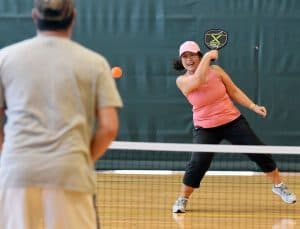
Image Credits: Daily Herald
The lob:
The lob is the most infamous shot in pickleball. When you and your opponent are stacked too close to the kitchen, a lob shot can be used to reset the pace of the game. A lob shot quickly bounces over your opponent’s head and when they run back to the court, you can take the net.
Around the pole:
When a ball goes around the net (not over the net) and a player of the opponent team hits it, it is considered as ‘Around the pole’ or ‘ATP’. It is a common move executed by players while playing and the skilled execution of this move can get you a point.
A Block shot:
There are times when you may face-off against an aggressive opponent who is constantly returning your serves with a powerful shot. It may seem like an impossible situation but if you know the block shot you can turn the game around.
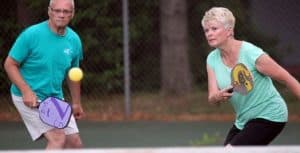
Image Credit: USAPA
Performing a block shot is very simple, you just have to stick out your paddle in a backhand position and let the ball collide with the bat. Since there is already too much force coming with the ball, you don’t need to swing the bat.
If you play the block shot correctly, the ball will simply go back into your opponent court with a limp that will make it hard to return. Block shots can lower the pace of the game so that you get an advantage.
Backhand Punch:
A backhand punch is a cool looking shot that can help you catch your opponent off-guard. The shot basically involves you punching the ball. All you have to do is put your paddle in the backhand position and pretend like you are punching. This shot can make a high dink into a targeted shot.
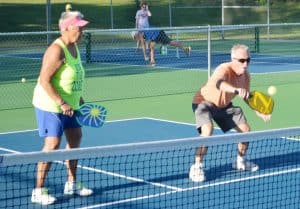
Image Credit: Lacrosse Tribune
Shot selection:
- If you don’t have a chance of playing an offensive shot, you should go for a drop shot or a dink. To learn how to hit a drop shot you can watch this video:
- If any or both of your opponents are at the back of the court, keep them there by hitting deep shots at a good pace. Keep them engaged in defense until you are sure that they will not be able to reach the net when you dink.
Strategies:
The key to winning any game is to have a strategy and in pickleball, there are different strategic approaches for every game. Here are some basic strategies that you can try to stay a step ahead of your opponents:
Strategy for a singles game:
A singles game is full of thrill and excitement as you and your opponent face each other off. It can be easy to win against a beginner but if you are playing against a pro, you have to play very carefully. Here are some strategic tips that can help you play like a pro:
- Play with deep serves and a good pace. Variation in the direction of the hits can be helpful but ensure they are in bounds.
- To get at most returns easily, a centreline serve can prove beneficial
- Keeping returns deep and to the corners can get you points
- Generally, try to stay at the back third of the court.
- Aim for the backhand of opponents; the majority of the players are weak at backhands.
- If you get a chance, hit a deep forcing shot into the corners, where your opponent will have to revert with a simple shot. This will give you a chance to come to the non-volley zone and hit a scoring shot.
- When your opponent is at the deep corners, avoid hitting a drop shot. A good player will get to it quickly and hit a passing shot.
- Move left and right but always try to be as close as possible to the center.
- The best possible ways to respond to a volley hit by your opponent while you are at the back is. 1. Hard passing shot, 2. A drop shot that lands at your opponent’s feet, 3. Playing a lob shot.
Strategies for a doubles game:
Doubles competition involves coordination, skill, and a good strategy. Even though you might have a great player with you, but that isn’t enough to put you in the front seat given that your opponents will be equally talented.
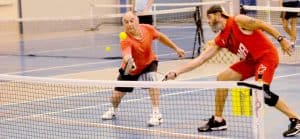
Image Credits: The Progress
To confirm your win, you can implement these strategies in your game:
Player positioning:
- The serving team stands behind the lines during the serve and remains to hit the return server after the ball bounces.
- The receiving team may stand behind the baseline to return serve, however, you have to be prepared for a return serve.
- The receiver’s partner may stand anywhere but usually stands at the kitchen line.
Getting to the net:
- Once the returning serve is hit, the receiver should quickly move forward to the kitchen line in a position parallel to his/her partner.
- Move quickly towards the Non-Volley Zone line together as soon as possible after the third shot.
- Never leave the NVZ unless it is necessary to return a lob shot. Once you have returned a lob shot returns to the NVZ line.
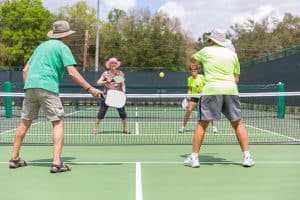
Image Credit: Senior Housing News
Move with your partner in unison:
- When and where the team moves, is decided by the partner hitting the ball
- Leave the baseline and move to the NVZ together with your partner in the angle he or she has hit the ball. Don’t leave before.
- Separated partners can create a winning shot for the opponent.
- When your partner is pulled to the sideline to return a shot, you should move towards the center to close the gap in the middle. The gap in the middle has higher chances of receiving a return than the left side that is open.
Understand pickleball is more about placement than power:
- The team that makes fewer unforced errors has higher chances of winning the game.
- According to a seasoned tournament player, 75% of the rallies are won (or lost) due to errors; only 25% are won by a good shot.
- Instead of trying to score with a winning shot every time, it is better to play near the nets and let your opponents do a mistake to hit a sure winner.
- The best place to hit a ball in a doubles game is the deep down in the middle. This minimizes your chances of hitting wide and can create confusion among the opponent team players over returning the ball
- The best place to earn an easy score is backhand, especially during the serve. The majority of the players are less comfortable hitting with their backhand and generate less power.
However, experienced players are proficient at playing backhands but due to the high power generated by the cross-body movement, these often result in over-hitting.
To understand the doubles strategy better you can watch this video:
Communicate with your partner:
- Start communicating with your partner by calling “Mine,” “I Go,” “Yours,” “You” or something similar for every shot. This is to be done especially when you are playing with an unfamiliar partner.
- Let the person with better speed take lob returns.
- Boost your team confidence by complimenting your partner on a good play, mostly when a rally ends. To avoid making matters worse, don’t criticize your partner’s faults.
Choosing the right equipment:
Pickleball doesn’t have a whole lot of equipment. The main gear comprises shoes, balls, and most importantly – A paddle.
Having the right paddle that supports your playing style can improve your game to a great extent. There are various factors that you must consider when choosing a pickleball paddle – Material, core, grip, weight, and length. For instance, in pickleball, paddles that are made of high-tech graphite have no weight or thickness barriers. As opposed to that, you have cheaper composite paddles and expensive fiberglass paddles.
Regardless of the paddles you choose, remember that it cannot exceed a total length of 24 inches.

There is a wide variety of paddles available in the market – legal and illegal paddles. As a player looking to turn professional, it’s advisable that you follow USAPA’s guidelines regarding pickleball paddles and try to use paddles that comply with its standards.
In terms of other pickleball equipment, the game is played with a Wiffle ball that is hollow and has a 1/3 speed of a tennis ball. And any decent sports shoes that offer good grip on turf courts can be useful.
Conclusion:
There are many things that make pro players stand out from a rookie – perseverance, practice, and a great presence of mind. You can develop these qualities on your journey towards becoming a successful pickleball player. I hope the above information helps you in becoming a pro player. If you have any queries or suggestions you can drop them in the comments below.
Leave a Reply